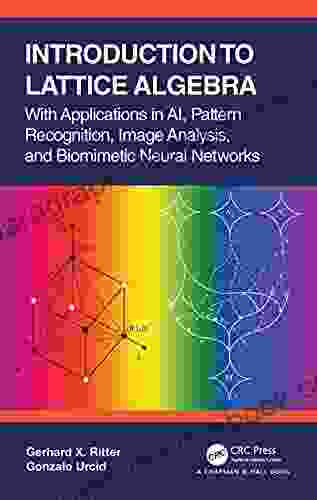Edge Detection With Applications In Ai Pattern Recognition Image Analysis And Biomimetic

5 out of 5
| Language | : | English |
| File size | : | 6035 KB |
| Print length | : | 298 pages |
| Screen Reader | : | Supported |
| Hardcover | : | 334 pages |
| Item Weight | : | 1.42 pounds |
| Dimensions | : | 6.14 x 0.75 x 9.21 inches |
Edge detection is a fundamental technique in computer vision and image processing. It is used to identify the boundaries of objects in an image, and can be used for a variety of applications, such as object recognition, image segmentation, and medical imaging.
How Edge Detection Works
Edge detection works by identifying the pixels in an image that have a significant change in intensity. These pixels are likely to be located on the boundaries of objects in the image. There are a number of different edge detection algorithms, each of which uses a different method to identify these pixels.
One of the most common edge detection algorithms is the Sobel operator. The Sobel operator uses a 3x3 convolution kernel to calculate the gradient of the image at each pixel. The gradient is a vector that points in the direction of the greatest change in intensity. The magnitude of the gradient is proportional to the strength of the edge.
Another common edge detection algorithm is the Canny edge detector. The Canny edge detector uses a 5x5 convolution kernel to calculate the gradient of the image at each pixel. The Canny edge detector also uses a thresholding step to remove weak edges from the image.
Applications of Edge Detection
Edge detection has a wide range of applications in computer vision and image processing. Some of the most common applications include:
- Object recognition: Edge detection can be used to identify the boundaries of objects in an image. This information can then be used to recognize the objects in the image.
- Image segmentation: Edge detection can be used to segment an image into different regions. This information can then be used to analyze the image and identify the different objects in the scene.
- Medical imaging: Edge detection can be used to identify the boundaries of organs and other structures in medical images. This information can then be used to diagnose diseases and plan treatment.
Edge Detection in AI
Edge detection is a fundamental technique in artificial intelligence (AI). AI systems use edge detection to identify the boundaries of objects in images and videos. This information can then be used to recognize objects, track objects, and understand the scene in the image or video.
Edge detection is used in a variety of AI applications, including:
- Object recognition: AI systems use edge detection to identify the boundaries of objects in images. This information can then be used to recognize the objects in the image.
- Object tracking: AI systems use edge detection to track the movement of objects in videos. This information can then be used to track the objects in the video and understand their behavior.
- Scene understanding: AI systems use edge detection to understand the scene in an image or video. This information can then be used to generate a description of the scene or to answer questions about the scene.
Edge Detection in Pattern Recognition
Edge detection is also a fundamental technique in pattern recognition. Pattern recognition systems use edge detection to identify the boundaries of patterns in data. This information can then be used to recognize the patterns and classify the data.
Edge detection is used in a variety of pattern recognition applications, including:
- Character recognition: Pattern recognition systems use edge detection to identify the boundaries of characters in images. This information can then be used to recognize the characters and transcribe the text.
- Face recognition: Pattern recognition systems use edge detection to identify the boundaries of faces in images. This information can then be used to recognize the faces and identify the individuals in the image.
- Fingerprint recognition: Pattern recognition systems use edge detection to identify the boundaries of fingerprints. This information can then be used to recognize the fingerprints and identify the individuals who made them.
Edge Detection in Image Analysis
Edge detection is also a fundamental technique in image analysis. Image analysis systems use edge detection to identify the boundaries of objects in images. This information can then be used to analyze the images and extract information from them.
Edge detection is used in a variety of image analysis applications, including:
- Medical imaging: Image analysis systems use edge detection to identify the boundaries of organs and other structures in medical images. This information can then be used to diagnose diseases and plan treatment.
- Remote sensing: Image analysis systems use edge detection to identify the boundaries of objects in remote sensing images. This information can then be used to map the land and monitor the environment.
- Industrial inspection: Image analysis systems use edge detection to identify the boundaries of defects in industrial products. This information can then be used to improve the quality of the products.
Edge Detection in Biomimetic
Edge detection is also a fundamental technique in biomimetic. Biomimetic systems use edge detection to identify the boundaries of objects in the natural world. This information can then be used to design new materials and technologies that mimic the natural world.
Edge detection is used in a variety of biomimetic applications, including:
- Biomedical engineering: Biomimetic systems use edge detection to identify the boundaries of organs and other structures in the human body. This information can then be used to design new medical devices and treatments that mimic the natural healing process.
- Robotics: Biomimetic systems use edge detection to identify the boundaries of objects in the environment. This information can then be used to design robots that can navigate and interact with the environment in a more natural way.
- Materials science: Biomimetic systems use edge detection to identify the boundaries of materials in nature. This information can then be used to design new materials that mimic the strength and durability of natural materials.
Edge detection is a fundamental technique in computer vision, image processing, pattern recognition, image analysis, and biomimetic. It is used to identify the boundaries of
5 out of 5
| Language | : | English |
| File size | : | 6035 KB |
| Print length | : | 298 pages |
| Screen Reader | : | Supported |
| Hardcover | : | 334 pages |
| Item Weight | : | 1.42 pounds |
| Dimensions | : | 6.14 x 0.75 x 9.21 inches |
Do you want to contribute by writing guest posts on this blog?
Please contact us and send us a resume of previous articles that you have written.
 Novel
Novel Chapter
Chapter Paperback
Paperback Magazine
Magazine Paragraph
Paragraph Sentence
Sentence Shelf
Shelf Glossary
Glossary Bibliography
Bibliography Preface
Preface Synopsis
Synopsis Footnote
Footnote Scroll
Scroll Codex
Codex Bestseller
Bestseller Classics
Classics Library card
Library card Narrative
Narrative Biography
Biography Memoir
Memoir Reference
Reference Thesaurus
Thesaurus Resolution
Resolution Librarian
Librarian Catalog
Catalog Borrowing
Borrowing Research
Research Scholarly
Scholarly Lending
Lending Reserve
Reserve Academic
Academic Journals
Journals Reading Room
Reading Room Rare Books
Rare Books Interlibrary
Interlibrary Thesis
Thesis Storytelling
Storytelling Awards
Awards Book Club
Book Club Theory
Theory Bryan Mccann
Bryan Mccann Ernle Bradford
Ernle Bradford Deborah Edmisten
Deborah Edmisten Gordon Brown
Gordon Brown Jing Jing Yang
Jing Jing Yang Margriet Ruurs
Margriet Ruurs Oliver Clarke
Oliver Clarke Denise Sullivan
Denise Sullivan Natalie C Parker
Natalie C Parker Harry Turtledove
Harry Turtledove K L Slater
K L Slater Guillermo Del Toro
Guillermo Del Toro Joseph C Zinker
Joseph C Zinker Katharine Beals
Katharine Beals Karl Jackson
Karl Jackson Michael P Spradlin
Michael P Spradlin Tina Orter
Tina Orter Ariel Sacks
Ariel Sacks Dandi Palmer
Dandi Palmer Antony W F Chow
Antony W F Chow
Light bulbAdvertise smarter! Our strategic ad space ensures maximum exposure. Reserve your spot today!

 Ronald SimmonsUnveiling the Gripping Psychological Thriller: A Labyrinth of Twists and...
Ronald SimmonsUnveiling the Gripping Psychological Thriller: A Labyrinth of Twists and... Oscar WildeFollow ·18.4k
Oscar WildeFollow ·18.4k Oscar BellFollow ·5.4k
Oscar BellFollow ·5.4k Patrick RothfussFollow ·3.6k
Patrick RothfussFollow ·3.6k Bob CooperFollow ·5.3k
Bob CooperFollow ·5.3k Denzel HayesFollow ·2.6k
Denzel HayesFollow ·2.6k Isaac MitchellFollow ·8.2k
Isaac MitchellFollow ·8.2k Simon MitchellFollow ·7.3k
Simon MitchellFollow ·7.3k Andrew BellFollow ·12.1k
Andrew BellFollow ·12.1k

 Ricky Bell
Ricky BellThe Marriage: An Absolutely Jaw-Dropping Psychological...
In the realm of...

 Ray Blair
Ray BlairDiscover the Enchanting Charm of Budapest and Its...
Nestled in the heart of...

 Tyrone Powell
Tyrone PowellHuddle: How Women Unlock Their Collective Power
Huddle is a global movement that empowers...

 Grayson Bell
Grayson BellThe Coin Story of the Holocaust: A Symbol of Hope and...
In the depths of the...

 Virginia Woolf
Virginia WoolfFolklore Performance and Identity in Cuzco, Peru: A...
Nestled amidst...

 Dylan Mitchell
Dylan MitchellThe Enduring Love Story of Héloïse and Abélard: A Tale of...
An Intellectual Passion In the heart of...
5 out of 5
| Language | : | English |
| File size | : | 6035 KB |
| Print length | : | 298 pages |
| Screen Reader | : | Supported |
| Hardcover | : | 334 pages |
| Item Weight | : | 1.42 pounds |
| Dimensions | : | 6.14 x 0.75 x 9.21 inches |










